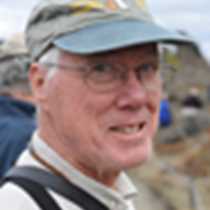Sandvika, West Norway
The National Geographic Explorer continues to make her way up the west coast of Norway in brilliant, sunny spring weather, occasionally visiting the open ocean but often behind a row of low, rocky skerries. Along the way we passed abundant evidence of two elements of the Norwegian economy: windmills and fish farms. Norway has invested a large part of its considerable North Sea oil revenue in infrastructure - roads, bridges, tunnels to connect the islands to the mainland, and windmills to generate electrical power (and the lavish new Oslo opera house). Much of their electricity comes from wind and hydro generation, and wind farms are sprouting up throughout the coastal region as their use of renewable energy increases.
For our afternoon outing we turned into the small fjord of Svesfjord , and then into even smaller Sandvika. We donned our beloved rubber boots, entered our Zodiacs, and headed for shore. No coaches today! Roads, wind farms, and ferry docks have not yet come to Sandvika; it was like stepping back into an earlier, less hectic world. There are a few, scattered summer cottages and, somewhere nearby, a farm, for we encountered a Norwegian gentleman and his dog tending their flock of sheep. For how many Norwegian generations has this land been so used? The ruin of a very old barn of dry stone construction tells us that it has been a long, long time.
The surrounding hills of granite were rounded and shaped by the passage of glaciers. Now birch forest creeps up the slopes, with an understory of blueberry bushes that promise rewards to come. A very old stone wall, falling into disrepair and covered with lichens, separates pasture from forest. A gentle stream makes its way through meadows dotted with yellow buttercups and marsh marigold before it enters the bay.
We separated into groups, each to enjoy the landscape in their own way. The long-walkers strode out resolutely along a wagon trail that followed the stream. Others progressed at a more leisurely pace, some to admire the flowers, others to capture images (we used to call it taking pictures) under the tutelage of our ever-helpful photo team.
And then it was back to our ship and floating home, the National Geographic Explorer, and on to the north, ever northward on our journey to the Arctic.




